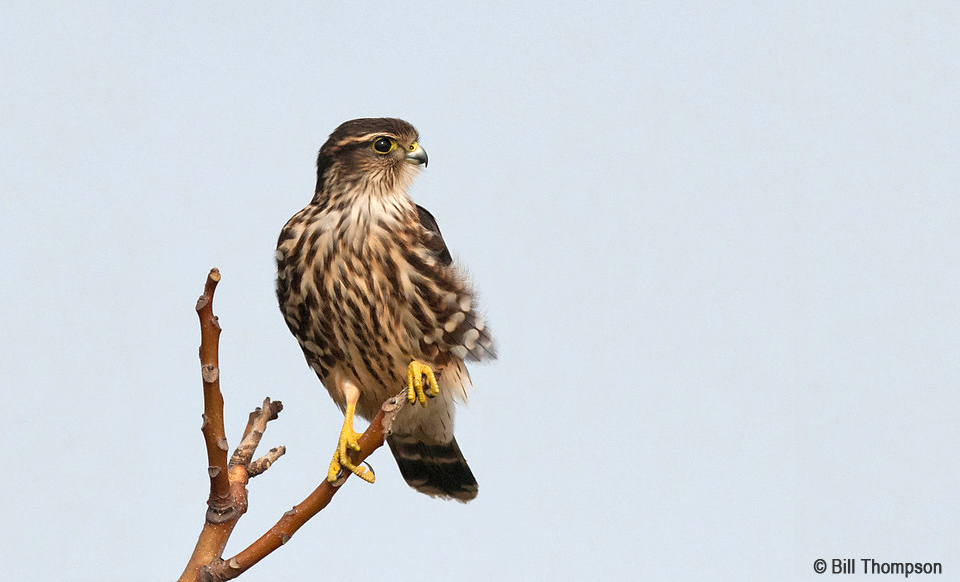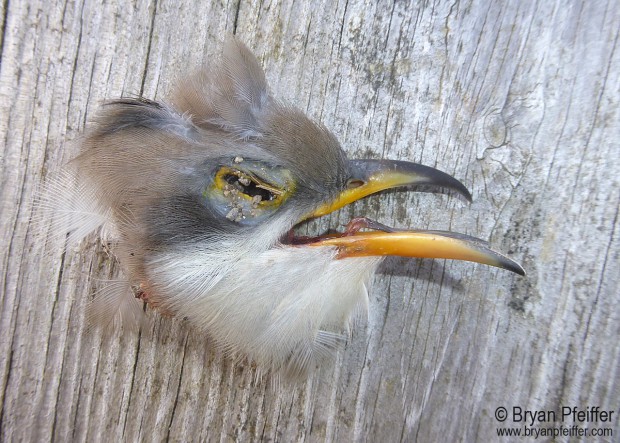Monhegan Migration Report No. 4: Summer Weather and Summer Tanagers
Hot and still on Monhegan Island. At dawn we smell bacon, seaweed and fog. Seals howl plaintively from the rocky island offshore known as West Duck. (At least, I think they’re seals — Gray Seals.) Channel markers clang to the slow cadence of soft waves. So calm is the sea that we can sense the curvature of Earth, which seems to have stopped spinning for the time being here on Monhegan.
Except for the Merlins and the flickers. They zoom and gyrate in the drama of predator and prey.
Ruth and I took in the morning from a bench below the lighthouse but high above Monhegan’s cemetery, meadow and village. Around us and below us, three Merlins and three Sharp-shinned Hawks chased Northern Flickers in open warfare, a natural event each fall on Monhegan. They’re doing what Merlins and sharpies do — fly around and kill things.
But most of the time the Merlins fail. Here on Monhegan, a dozen miles offshore, the migrants are mostly young of the year on their first journey south. The young Merlins are still learning to kill. The Northern flickers are fat targets that for the most part seem skilled enough at evasive maneuvers. But when chased, the flickers utter a woeful alarm call I rarely hear on the breeding grounds, yet is so common here that we’ve dubbed it “FID” (Flicker in Distress).
Some birds don’t escape, off course, like the Yellow-billed Cuckoo (head only) that Matt Schweier found the other day. Could be a Merlin got it, or maybe one of the Monhegan cats (which own the island). Matt’s been asking whether I’ve yet “tweeted” a photo of his cuckoo head. SO FAIR WARNING: it’s below.
This southern high pressure has put the brakes on the migration — except for the southerners, including two Summer Tanagers not far from the Monhegan Church. (Ruth and I haven’t seen them yet.) We’re still picking up warblers in ones and two (with our trip tally now at 20 warbler species). We’re in LPBM (Low-Powered Birding Mode) watching the easy stuff: butterflies, dragonflies and gulls. A Minke whale fed not far offshore from White Head this afternoon.
The easy warmth here today, gives us time to think about non-avian life on this island. Having come here each fall for the better part of two decades, I actually know the trees and the rocks and birds on this island better than I know its people. I am grateful, however, to meet and get to know more and more of the select few hardy souls who live here year-round, as well as the many others who contribute to life on this tiny island. It’s a cast of merchants, lobster fishermen, inkeepers, artists, actors, misfits, scholars and other personalities packed into a small town — a very small town. I’ll write more on the community later, including my nascent plans to give back to this island that gives shelter to birds and birdwatchers alike. Most of us, after all, are guests in this place.
In the meantime, for birders who might be coming, here’s some advice on Monhegan Birding Etiquette:
- Move. Two dozen or more pickups surge and sputter along Monhegan’s rugged dirt roads. That’s it for traffic (not counting golf carts and Matt’s Bobcats). Soon they’ll be hauling lobster traps to the wharf. By way of respect for hardworking islanders who drive, birders would do well to get out of the way of pickups pronto – no matter how rare the bird in sight.
- Buy Stuff. This island economy depends in part on visitors. In their determination to see winged beauty, birders sometimes forget to leave money. Mention birders, and some of the locals make their own bird calls about us: “cheap-cheap.” So, yeah, buy stuff.
- “Rump” is what we call Yellow-rumped Warbler. It’s not an insult (until perhaps you’ve seen 1,000 Yellow-rumped Warblers). When the island is lousy with Rumps, which will be soon, your challenge is to not look at a Rump. When you don’t, you’re more likely to find other warbler species.
- Visit the Monhegan Museum or Art and History. Up at the Lighthouse. Open 1:30-3:30PM. Don’t miss it.
- Black-capped Pipidees. Nope, that call is not an American Pipit (well, sometimes it is). But the chickadee dialect here includes a distinctive “pipit!” vocalization. Took me a few years to discover this.
- Report Birds. Let’s use a Twitter hashtag #monheganbirds for rare stuff. Also, stop by the Black Duck Emporium (say hello to Barbara and Pam) and report your rare bird sightings in the log book — yeah, a place to write stuff down on actual paper. Imagine that.
Meanwhile, here’s our updated bird list (90 species):
- American Black Duck
- Mallard
- Common Eider
- Ring-necked Pheasant
- Common Loon
- Northern Gannet
- Double-crested Cormorant
- Great Cormorant
- Black-crowned Night-Heron
- Osprey
- Northern Harrier
- Sharp-shinned Hawk
- Cooper’s Hawk
- Bald Eagle
- Spotted Sandpiper
- Greater Yellowlegs
- Whimbrel
- Least Sandpiper
- Black Guillemot
- Laughing Gull
- Herring Gull
- Lesser Black-backed Gull
- Great Black-backed Gull
- Mourning Dove
- Ruby-throated Hummingbird
- Belted Kingfisher
- Downy Woodpecker
- Northern Flicker
- American Kestrel
- Merlin
- Peregrine Falcon
- Eastern Wood-Pewee
- Least Flycatcher
- Eastern Phoebe
- Eastern Kingbird
- Great Crested Flycatcher
- Blue-headed Vireo
- Warbling Vireo
- Philadelphia Vireo
- Red-eyed Vireo
- Blue Jay
- American Crow
- Common Raven
- Barn Swallow
- Black-capped Chickadee
- Red-breasted Nuthatch
- House Wren
- Carolina Wren
- Golden-crowned Kinglet
- Ruby-crowned Kinglet
- Blue-gray Gnatcatcher
- American Robin
- Gray Catbird
- Brown Thrasher
- European Starling
- Cedar Waxwing
- Northern Waterthrush
- Black-and-white Warbler
- Tennessee Warbler
- Nashville Warbler
- Common Yellowthroat
- American Redstart
- Cape May Warbler
- Pine Warbler
- Northern Parula
- Magnolia Warbler
- Bay-breasted Warbler
- Blackburnian Warbler
- Yellow Warbler
- Blackpoll Warbler
- Black-throated Blue Warbler
- Palm Warbler
- Yellow-rumped Warbler
- Prairie Warbler
- Black-throated Green Warbler
- Wilson’s Warbler
- Yellow-breasted Chat
- Lark Sparrow
- White-throated Sparrow
- Song Sparrow
- Chipping Sparrow
- Northern Cardinal
- Rose-breasted Grosbeak
- Dickcissel
- Bobolink
- Red-winged Blackbird
- Yellow-headed Blackbird
- Common Grackle
- Brown-headed Cowbird
- Baltimore Oriole
- Purple Finch
- Pine Siskin
- American Goldfinch




Thanks Charlie. I’ve got a Boise contingent with me here — friends of Louise.
Thanks, Kim. In nearly 20 years of birding here in the fall, I’d guess that I’ve seen (or heard) Whimbrel three or four times.
A whimbrel? I’ve only seen them once here, I my yard in late fall.
Love to read your notes. Monhegan comes to life, and you write about it beautifully.